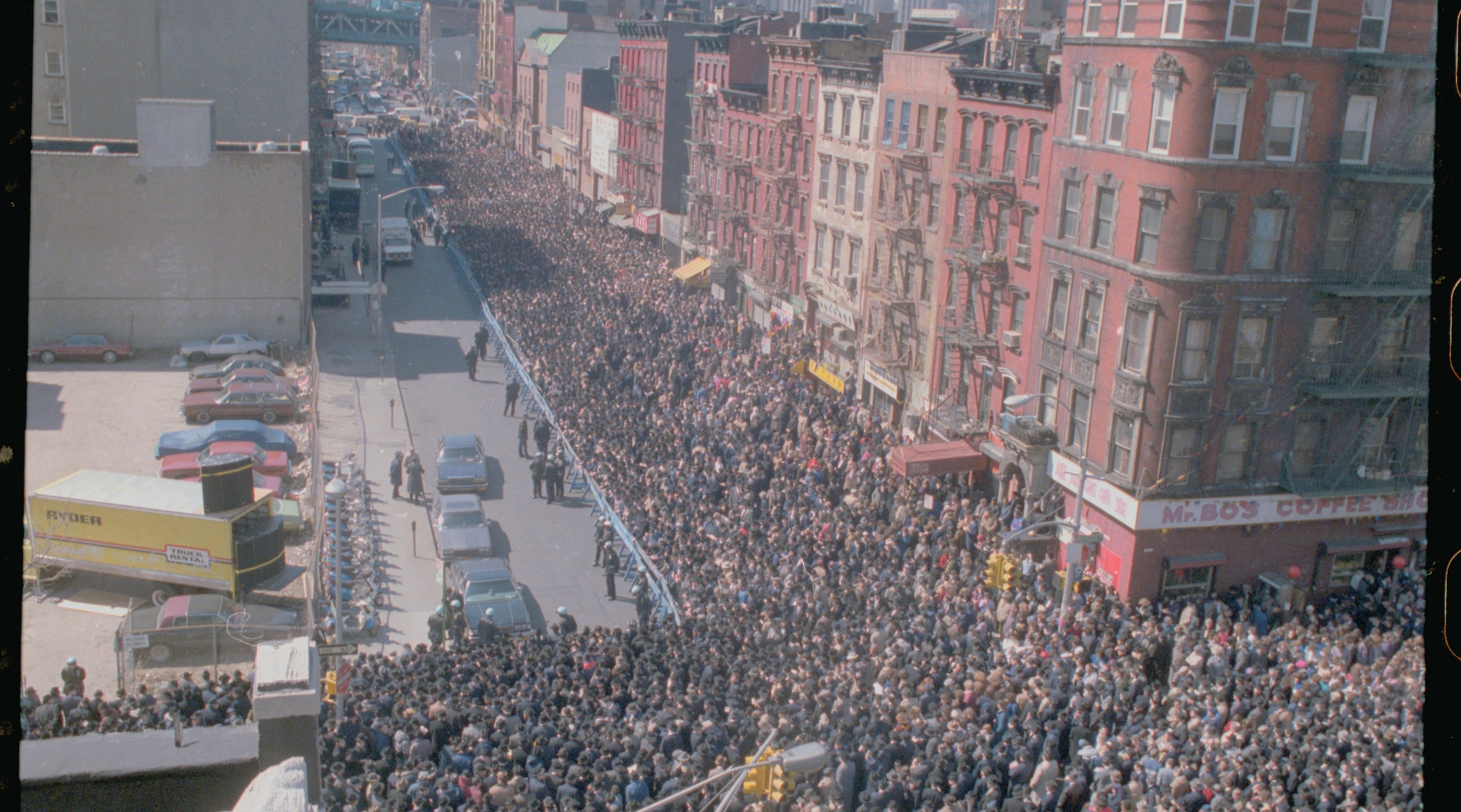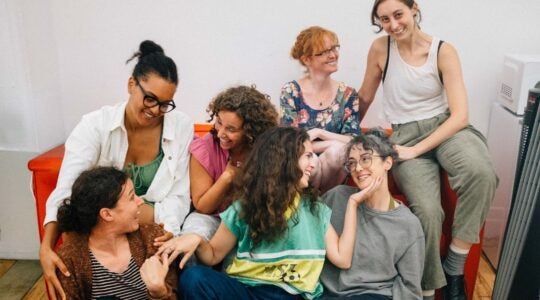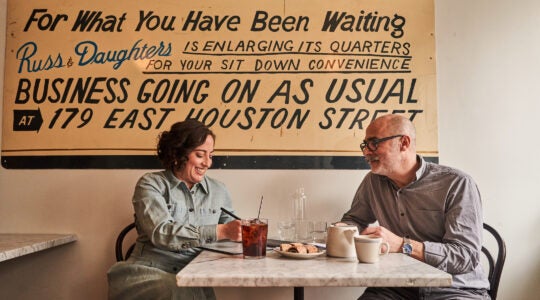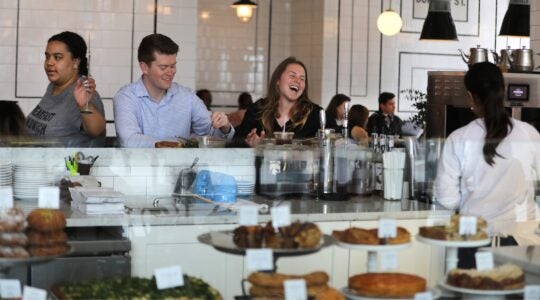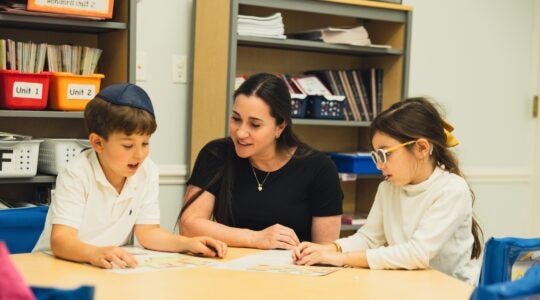(New York Jewish Week) — In a different time, I would have asked Jonathan Boyarin to take me on a walking tour of the Lower East Side, near where he lived for 40 years. He might have shown me the synagogues that were sold to developers, or the former old age homes that served what had once been a strong, organized Orthodox community.
And we would have ended up at the Mesivtha Tifereth Jerusalem yeshiva at 145 E. Broadway, what he calls one of the last survivors of a “network of institutions that has been gradually dwindling for decades.”
Instead, Boyarin and I spoke by Zoom about his new book, “Yeshiva Days: Learning on the Lower East Side” (Princeton University Press), an account of the year he spent in kollel, or full-time text study, among the regulars at “MTJ,” New York City’s oldest yeshiva. During the 2012 academic year, Boyarin, the Diann G. and Thomas A. Mann Professor of Modern Jewish Studies at Cornell University, doffed his anthropologist’s cap to join study partners in dissecting the Talmud, its commentaries and the commentaries on those commentaries that make up the yeshiva canon.
The book is a study of the varieties of religious experience among a small and perhaps unrepresentative slice of Orthodox Jewry, an examination of the purposes and pleasures of studying esoteric texts, and a look at a changing neighborhood, which he last chronicled in his 2011 book, “Mornings at the Stanton Street Shul: A Summer on the Lower East Side.”
It is also a reflection on the “Lithuanian tradition of rational Judaism” embraced by MTJ’s Rosh Yeshiva, Reb Dovid Feinstein, who in turn is carrying on a tradition of his father, the late Rabbi Moshe Feinstein, the leading Orthodox posek (decisor) of his generation.
Boyarin spoke to The Jewish Week from his home in Ithaca, NY. At the outset I mentioned that I had once taken a course with his brother Daniel Boyarin, a professor of Talmudic Culture at UC-Berkeley who has written widely about Judaism and gender.
New York Jewish Week: You didn’t have a yeshiva upbringing. Where did you acquire the skills to study Jewish text in Hebrew, Aramaic and Yiddish?
Jonathan Boyarin: I grew up with after-school Hebrew school in the Conservative movement, so I had a lot of familiarity with traditional forms of synagogue worship but was not formally educated. When my brother Daniel decided to become committed to Jewish scholarship, it was Talmud that drew him very early in his 20s. I was first drawn to Yiddish language and culture and community life and its transformations. So in fits and starts I did some informal study, then most intensively in what I call in the book my “kollel year.”
The book focuses mainly on the calendar year 2012, when I was on leave from my job at the University of North Carolina for the spring and fall semesters. Late in the spring the friend who I call Yisroel Ruven said he was going to the kollel dinner and expected me to be there, “since you’re a member of the kollel.” I’ve thought of adding “kollel MTJ” to my CV, though I never formally registered.
What is the language of instruction at MTJ?
Primarily English. The Rosh Yeshiva gives his shiur in English. I’m sorry I missed one day when the Rosh Yeshiva gave his shiur in Yiddish. There are a few Bratslaver chasidim who study in Yiddish. And even for those who aren’t fluent, Yiddish is a mark of authenticity and identification. So my own fluency in Yiddish is one of those things that made it easier to become part of the group even if I didn’t fit the mold.
You describe MTJ as a yeshiva without a large community surrounding it, unlike the major yeshivas in Lakewood, NJ, or Rockland County that are the center of booming Orthodox communities. How did that shape your experience there?
The Lower East Side Jewish population peaked in the early 1920s and has been declining for a century. Some of the people at MTJ live on the Lower East Side but many come from other parts of the city and New Jersey. Being in a place where the institutional capacity exceeded the needs of the population, combined with the legacy of openness and diversity on the Lower East Side and especially in the spirit of Reb Moshe Feinstein, made it a more congenial place for me — certainly compared to Lakewood or Monsey, where it appears you have to be in or out. It’s similar to joining a minyan: a place where they have nine guys and they are waiting for the tenth for a minyan is going to be a lot less picky about what he looks like and how he talks than a place that is already packed to the gills. Living on the Lower East Side for forty years, I saw that this made it possible for me to participate in traditional Jewish religious forms without becoming wholly subject to the stringent norms of the community.
What role does MJT serve in the wider Jewish world if it is not associated with a movement or community?
When Reb Dovid Feinstein gives his shiur, he is in a room with at most 15 students, yet he is regarded as one of the top halachic authorities in the world today. So his reputation is clearly not on the basis of his institutional reach, and that is also consistent with his character – he is not a self-aggrandizing person and has been very cautious in rulings that might be generalized beyond the case he is talking about. The yeshiva is treasured in large part because it is one of the major remaining functioning Jewish communal institutions of the Lower East Side, a continuation of Moshe Feinstein’s legacy and a mark of continuity and vitality.
You wrestle with the traditional ideal of Torah leshma, or learning Torah for its own sake. How do you describe to outsiders what the point is of full-time learning if it doesn’t lead to a degree, or tenure, or some kind of material reward? What does full-time learning mean to you?
There is a funny logical hitch there – to talk about motivations is removing it from the idea of study for its own sake. I never asked somebody, “why are you doing this?” or “do you really believe in an eternal life?” I can’t rule out that some or all fully believe that investing this time in something that seems materially non-productive helps guarantee them eternal life.
For myself, there is a sense of communication and engagement with minds and lives from earlier centuries and millennia, and that is enormously comforting. It reduces my anxiety not only about my own mortality but about the perilous future of our species.
And also the face-to-face engagement with others over a shared text — this social form of study in a way that is at once timeless because the patterns were set centuries ago, but also set in the everyday calendar world of today. This helps reduce the sense of catastrophic loss that also characterizes Jewish experience in the 20th century.
People also do it because it is valued within their world. The fellow student who I call Asher in “Yeshiva Days” — I asked him once, “Does your wife approve of this?” He said, “She absolutely approves; if she didn’t I wouldn’t be doing it.” That’s not to say there aren’t tensions or ambivalences. But people do participate in a social world where what they are doing gets some moral validation.
Learning Torah helps reduce the sense of catastrophic loss that also characterizes Jewish experience in the 20th century.
Your book is neither straight memoir nor a forensic book of anthropology. Who were you in the building that year?
I knew from very early on that if I had to decide between being able to continue to study at MTJ and writing a book, I would sacrifice the book. There were long periods where I was studying regularly and not taking notes. Because so much of my work has been close to home, I define field work as those times when I’m keeping an ethnographic journal. At MTJ, I wasn’t doing interviews. At the same time, being an anthropologist made it a little easier for me psychologically when confronted with moments when I knew my gut values were different than those being expressed by my comrades. And I had some orientation to the ground rules when I started. By the time I walked in there in 2011, I knew enough about the axiomatic assumptions of Talmudic study that I knew not to say, “Well, maybe the Mishna is wrong.”
The Orthodox world is much more diverse than many people might realize, with differences and sometimes tensions between chasidic Jews and so-called “mitnagdic” Orthodox, or the insular charedi Orthodox and the more worldly Modern Orthodox, and dozens of variations among them. Where does MTJ fit into this?
MTJ takes its place within the mitnagdic, or Litvak or Lithuanian tradition, whose yeshivas blossomed in the 19th century. Like a lot of such institutions there is not the same sense of the historic opposition to chasidism as there once was. It’s feasible for chasidim to be regularly associated with MTJ. There the historical distinctions get thematized but are not operative divides now. Much of what’s distinctive today at MTJ is focused around the figure of Reb Dovid Feinstein. By remaining sufficiently within the moving consensus between Orthodoxy and charedi Orthodoxy, while retaining some of the traditional (not traditionalist) common sense reasoning that characterized so many of his father’s rulings, I’ll go out on a limb and say for a lot of people, the Rosh Yeshiva has made MTJ the last bastion of Orthodoxy without qualifiers.
You are referring to the recent tendency for the Orthodox world to become more strict in its religious practice and more resistant to engaging with the modern, secular world.
Right, at MTJ there is room to maintain some space in the middle. That’s why I wrote this book. For me personally, that was part and parcel of something that feels to me down to earth and rooted in a place and community while not trying to be abstracted from a changing world.
An example you give in the book is Reb Moshe Feinstein’s ruling that dairy products require only an ordinary kosher certification, and not the more stringent cholov yisrael standard that has grown more prevalent in the charedi world.
There is only one photograph in the book – it’s of a sign warning people that a cake left on a table at the yeshiva is OU dairy and not cholov yisrael. Officially the yeshiva still follows Reb Moshe Feinstein’s ruling on dairy, but the sign shows an awareness that perhaps most of the regulars there no longer would personally abide by that ruling. I find that poignant and funny at the same time.
I know you were studying Torah for its own sake, but has it had an impact on your secular scholarship?
I’m more confident in being able to integrate rabbinic materials into my lessons when appropriate. I’m teaching a course on Jewish diasporas right now, and I started the first class with the Mishna in Kedushin that talks about people that Ezra supposedly took with him when he left Babylonia to Israel. It was useful in discussing ideological distinctions between the diaspora and the Holy Land.
And when I am not able to come to MTJ I spend a lot of time studying on my own with more fluency than I used to have, or three or four times a week remotely – including a weekly session with the friend I call Nasanel in “Yeshiva Days.” We do it by phone.
He’s the one who told you, “Learning with you is my top priority. Saving your soul is secondary.”
He acknowledged that he was working on me also [to become more religious] – but also that the comradeship of study has a value that is independent of each Jew’s responsibility for the soul and faith and practice of another Jew.
You acknowledge the yeshiva is an all-boy’s club, but decided not to delve into the gendered aspects of traditional Torah learning. What insights didn’t make it into the book?
I am very aware of the disconnect. Unlike my brother, whatever my feminist values or concerns are, I have never been very good at a critical integration of those with my concerns in documenting and identifying with what I call tradition and continuity. Both colleagues and family members repeatedly called me on this during my time at yeshiva and while I was writing the book. It wasn’t necessarily “how could you be so invested in a sexist institution!” but rather “there is so much more you can say about how gender works in this institution!” And those are central issues and fascinating research questions, but I was also determined that if I was going to publish a book, it would be something I could bring into the beis medresh and could hand a copy to the Rosh Yeshiva. I ended with something between what the [traditionalist publisher] ArtScroll would have published, and something that an anthropologist less identified with the institution and less committed to belonging there might have produced.
What is your own religious practice?
I try to avoid saying, “Yes, I am an Orthodox Jew.” The synagogues I am comfortable at are all Orthodox. We’ve tried to maintain a home where people who observe kashrut strictly can be comfortable as guests. I do my best to keep Shabbas and Yontiff strictures. Still, I never thought of myself as a “baal teshuva” in the sense that I was raised wrong or beat myself up over doing things I don’t want to talk about in the yeshiva.
It’s my firm belief that the more people learn and engage in whatever realms of Jewish thought, tradition and practice, the more capable they are to determine what kinds of Jews they are going to be and become. I think of Jewishness as a becoming – not the making of a fully autonomous self, because there’s always a prehistory to it, something that was there before us. But there is also an aspect of self-making that makes it a rich adventure.
The New York Jewish Week brings you the stories behind the headlines, keeping you connected to Jewish life in New York. Help sustain the reporting you trust by donating today.
